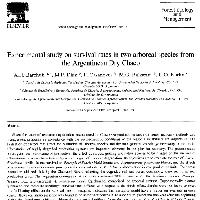Resumen
- Given the state of resource degradation encountered in Chaco (Argentina), research on forest recovery methods and management proposals in accordance with the socioeconomic conditions of the region's inhabitants are imperative. The evaluation of factors that affect the plantation of arboreal species and the management knowledge necessary in the initial afforestation of highly degraded production systems are important elements in the plan for recovery. The present study investigates the importance of the factors: the effect of shrubs, grazing and native species to be planted on the success of afforestation in areas characterized by a high degree of resource degradation. Its objectives are to evaluate the role of Larrea divaricata ‘jarilla’ in the survival of Prosopis chilensis (Mol.) Stuntz and Aspidosperma quebracho blanco, and the effects of attenuated levels of domestic grazing on the survival rate of P. chilensis afforestation in real production units. Four areas located in old beds left by the Chancaní River, reflecting the degraded soil and forest conditions, were set up as real production units. The vegetation community at each site contained 70% L. divaricata, the dominant species. Prosopis flexuosa D.C. and emergent A. quebracho blanco (quebracho) comprised the arboreal stratum. Experimentally planted quebracho and mesquite seedlings' survival rates differed with respect to the shrub-effect. Shrubs were not found to exert any facilitating effect on the survival rate in mesquite, indicating that mesquite would have a higher survival rate in open spaces. However, shrub presence was found to be somewhat beneficial to survival in quebracho one year after the beginning of the trial. Herbivores with and without shrubs were a significant factor decreasing survival in P. chilensis.
